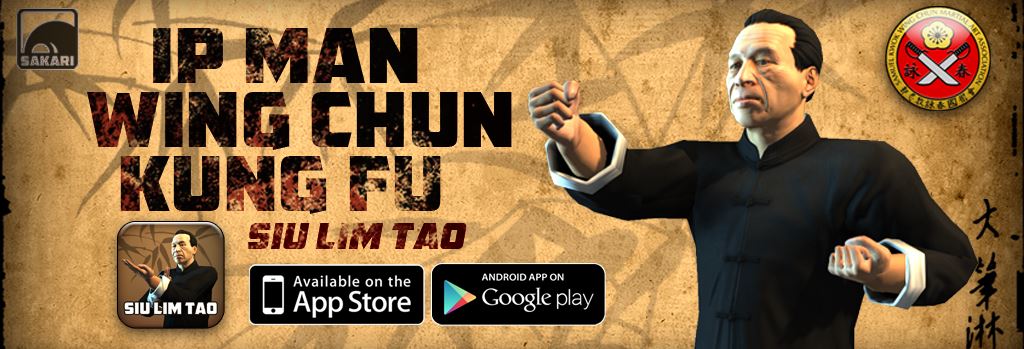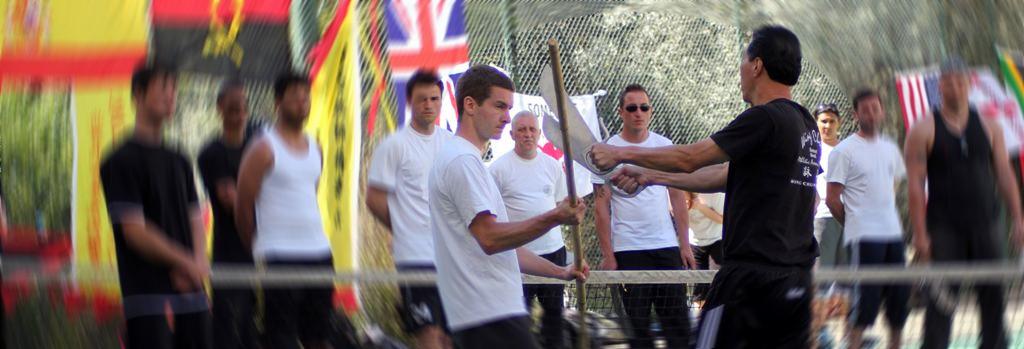Biu Ma Stepping
Article by Dan Knight added on 2 Aug 2012. Last updated on 2 Aug 2012.
Wing Chun thrusting / forward stance
Biu Ma is the name of the standard Wing Chun footwork and means thrusting / forwards stance. It is developed in the second form Chum kiu.
Biu Ma is footwork from Chum Kiu
 Biu Ma or thrusting stance is used to refer to the kind of stance and footwork developed in Chum Kiu. Wing Chun's stepping is designed to give its practitioner maximum stability, whilst maintaining maximum security from attack. The basic position of one's feet when using Biu Ma is as follows: Feet are approximately shoulders width apart or slightly over, and the feet are at 45 degrees. The power for the stepping comes from ankle strength built through the Achilles tendon, as well as leg strength. The power for the step is thrust from the back leg. The practitioner should power down into the ground with the back leg, and then thrust the power out, remembering to move the front leg first. Always check the position of the feet when in place. Do not leave feet too close together or too far apart. A common mistake is to stand on your toes, but this prevents the generation of extra power in the step, and also compromises the structure of the practitioner.
Biu Ma or thrusting stance is used to refer to the kind of stance and footwork developed in Chum Kiu. Wing Chun's stepping is designed to give its practitioner maximum stability, whilst maintaining maximum security from attack. The basic position of one's feet when using Biu Ma is as follows: Feet are approximately shoulders width apart or slightly over, and the feet are at 45 degrees. The power for the stepping comes from ankle strength built through the Achilles tendon, as well as leg strength. The power for the step is thrust from the back leg. The practitioner should power down into the ground with the back leg, and then thrust the power out, remembering to move the front leg first. Always check the position of the feet when in place. Do not leave feet too close together or too far apart. A common mistake is to stand on your toes, but this prevents the generation of extra power in the step, and also compromises the structure of the practitioner.
As previously stated, Wing Chun's stepping is designed to give its practitioner maximum stability, whilst maintaining maximum security from attack. Feet should be slightly over shoulders width apart as this gives maximum stability. Further apart and the balance is too spread and the legs become very vulnerable targets. Any closer and the legs have little balance as all your weight is balancing on a small area. Feet should be at approximately 45 degrees and parallel. If they are both square on in a forward direction, they are immobile,  and if they are square on at any direction [see next diagram], they expose the knee joint and shin area to attack. It will also inhibit the practitioner when changing direction to deal with an attack from the side or behind if the feet are square on. Knees should be slightly bent because straight legs break when struck at the knees. Also if the legs are bent, they are like a coiled spring ready to move. Almost all of the practitioner's weight should be on the back leg, which enables for a fast advance and retreat as one leg is thrusting forward, back or to the side. This also means weight does not have to be shifted to kick with the front leg as it can move without disrupting the balance if no weight is on it. Therefore, with the weight on the back leg, front kicks can be performed easily and swiftly. Furthermore, having weight on the back leg prevents an attack to the front leg being as dangerous to your balance. This is useful because the front leg is the most likely to be attacked. The feet should be flat on the floor when stationary as opposed to being up on the toes as this gives a more stable surface on which to fight. It is no use fighting on stilts because your balance, rooting, and overall structure will be compromised. Standing on your toes is like fighting on stilts. The feet should be flat and only push up onto the toes when pushing off during stepping. Once the step is complete, the foot must always be firmly rooted to the ground.
and if they are square on at any direction [see next diagram], they expose the knee joint and shin area to attack. It will also inhibit the practitioner when changing direction to deal with an attack from the side or behind if the feet are square on. Knees should be slightly bent because straight legs break when struck at the knees. Also if the legs are bent, they are like a coiled spring ready to move. Almost all of the practitioner's weight should be on the back leg, which enables for a fast advance and retreat as one leg is thrusting forward, back or to the side. This also means weight does not have to be shifted to kick with the front leg as it can move without disrupting the balance if no weight is on it. Therefore, with the weight on the back leg, front kicks can be performed easily and swiftly. Furthermore, having weight on the back leg prevents an attack to the front leg being as dangerous to your balance. This is useful because the front leg is the most likely to be attacked. The feet should be flat on the floor when stationary as opposed to being up on the toes as this gives a more stable surface on which to fight. It is no use fighting on stilts because your balance, rooting, and overall structure will be compromised. Standing on your toes is like fighting on stilts. The feet should be flat and only push up onto the toes when pushing off during stepping. Once the step is complete, the foot must always be firmly rooted to the ground.



